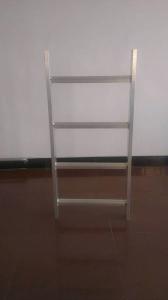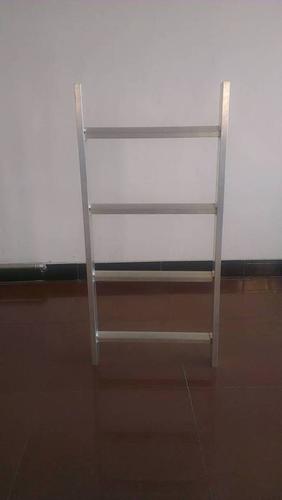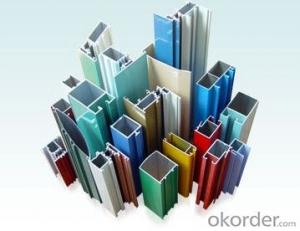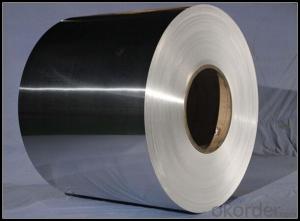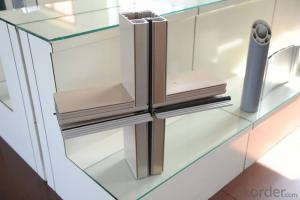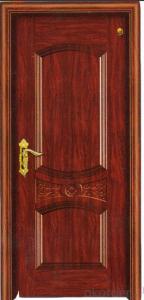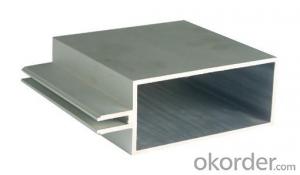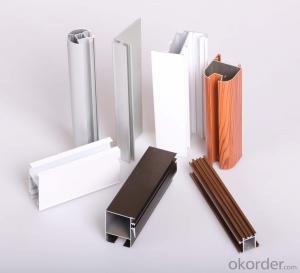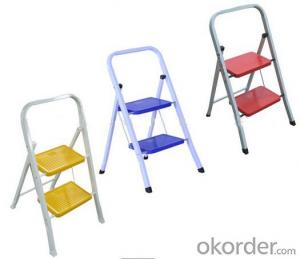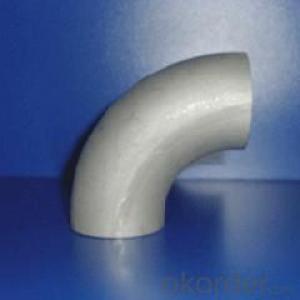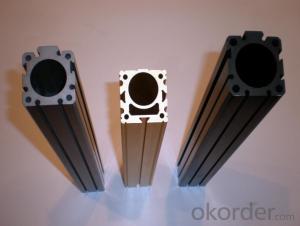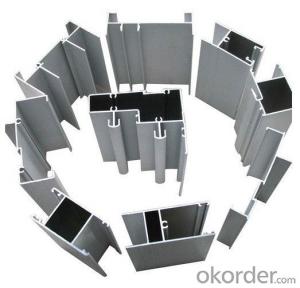Aluminum Windows Profiles Household Step Ladder
OKorder Service Pledge
OKorder Financial Service
You Might Also Like
Lightweight, easy to carry
Alloy: 5xxx and 6xxx
High quality: anticorrosion, rust protection and easy clean surface
Maximum loading capacity: 150kg
Number of steps: 4
Standard package: suitable for long ocean transporting
OEM&ODM is welcome
Last for life time
Specifications
1. Aluminium Ladder
2. Silver Matt Anodizing
3. Reasonable Price
4. Satisfied Service
5. Prompt DeliveryProduct Advantages
1. Plenty of surface treatments for your choice
2. Strict control for surface finish, very little scratch.
3. Accurate mold as well as accurate size.
4. Standard alloy composition aluminium ladder
5. Both ends of the profiles are very plain and with no burr.
- Q: How do aluminum profiles perform in terms of heat resistance?
- Aluminum profiles generally exhibit good heat resistance. Aluminum has a high thermal conductivity, allowing it to efficiently dissipate heat. Additionally, aluminum profiles can withstand high temperatures without deforming or losing structural integrity. However, extreme temperatures, especially above 600°C, can cause aluminum to gradually lose strength. Therefore, it is important to consider the specific application and temperature requirements when evaluating the heat resistance of aluminum profiles.
- Q: A curtain wall predecessors?For example, under the transverse frame section, with 6m specifications, why should the material processing and minus 50mm? Insert plate, plate to cut 100mm head? What is the law?
- As you said the core insert to reduce 100mm plate plate, this is because the length of processing of these parts is relatively small, some ten centimeters in length, the process if you use a single head saw or double saw large mechanical cutting, base metal processing machinery in a relatively short time finally can not be cut, that is to say the last 100mm~150mm machine cannot continue cutting, it is useless.
- Q: Can aluminum profiles be an alternative to steel or iron?
- Aluminum profiles offer a viable alternative to steel or iron in numerous applications due to their lightweight, durability, and exceptional resistance to corrosion. These qualities make them suitable for diverse industries like construction, automotive, aerospace, and electrical. Unlike steel or iron, aluminum exhibits a high strength-to-weight ratio, enabling it to provide equivalent strength while being significantly lighter. Consequently, aluminum profiles are easier to handle, transport, and install, resulting in reduced overall costs. Moreover, aluminum profiles can be easily extruded into intricate shapes, allowing for design flexibility and customization. Nevertheless, it is crucial to acknowledge that aluminum profiles might not be suitable for all applications requiring the high strength or hardness offered by steel or iron. Hence, the decision between aluminum, steel, or iron profiles will rely on the specific requirements of the project or product.
- Q: What is the composition of aluminum profiles?
- Aluminum profiles are typically composed of aluminum alloy, which is a combination of aluminum and other elements. The specific composition of aluminum profiles can vary depending on the intended use and desired characteristics. Common alloying elements include copper, magnesium, silicon, and zinc. These elements are added to enhance the strength, durability, and corrosion resistance of the aluminum profiles. Additionally, trace amounts of other elements may be present to further refine the properties of the profiles. Overall, the composition of aluminum profiles is carefully engineered to ensure optimal performance and versatility in various applications.
- Q: How do I maintain and clean aluminum profiles?
- Achieving and upholding the cleanliness and maintenance of aluminum profiles can be accomplished by adhering to the following guidelines: 1. Consistent dusting is key: Commence by employing a gentle cloth or feather duster to eliminate loose dust or dirt. This will hinder the accumulation of grime and simplify the subsequent cleaning process. 2. Create a cleaning solution: Combine warm water with a mild detergent or dish soap in either a bucket or spray bottle. It is important to avoid the usage of harsh chemicals or abrasive cleaners, as they have the potential to cause damage to the aluminum surface. 3. Thoroughly clean the profiles: Immerse a soft cloth or sponge into the cleaning solution and delicately scrub the aluminum profiles. Particular attention should be given to areas that exhibit stains or stubborn dirt. 4. Rinse with fresh water: Subsequent to cleaning, it is crucial to thoroughly rinse the profiles with clean water to eliminate any residual soap or cleaning solution. This step is essential in preventing the formation of streaks or marks caused by dried residue. 5. Dry the profiles: Employ a soft, dry cloth or towel to meticulously wipe the aluminum profiles until they are completely dry. This will help prevent the formation of water spots and preserve the metallic shine. 6. Optional polishing: If desired, a non-abrasive aluminum polish can be applied to further enhance the shine and safeguard the surface. For optimal results, adhere to the instructions provided on the polish packaging. 7. Regular upkeep: In order to maintain the aluminum profiles in excellent condition, it is imperative to engage in regular maintenance practices. This includes consistent dusting, avoiding the usage of abrasive materials or cleaners, and promptly addressing any stains or spills. By adhering to these steps, you can effectively maintain and clean aluminum profiles, thereby ensuring that they retain their pristine appearance for extended periods of time.
- Q: What are the different bending radii available for aluminum profiles?
- The different bending radii available for aluminum profiles can vary depending on the specific profile and its dimensions. However, common bending radii for aluminum profiles typically range from 1.5 to 3 times the profile's wall thickness.
- Q: What do you mean by aluminum alloy T3-T8? Someone who answers me, thanks a lot
- T5It is cooled by a high temperature molding process and then artificially agedThe utility model is suitable for the artificial aging product after being cooled by the high temperature forming process without being cold processed (which can be straightened and straightened without affecting the mechanical performance limit)T6The state of artificial ageing after solid heat treatmentSuitable for solid melting heat treatment, no longer cold processing (can be straightened, leveling, but does not affect the mechanical performance limit) productsT7The state of over ageing after solid heat treatmentSuitable for solid heat treatment, in order to obtain some important characteristics, in artificial aging, the strength on the aging curve crossed the peak point of the productT8 solid fusion heat treatment, after cold processing, and then the state of artificial agingSuitable for cold processing, or straightening, leveling, in order to improve the strength of products
- Q: This question asks if aluminum profiles can be used in cold weather conditions and if they maintain their properties in such environments.
- <p>Yes, aluminum profiles are suitable for use in cold climates. Aluminum is a durable material with excellent resistance to corrosion and weathering, which includes maintaining its integrity in low temperatures. It does not rust or degrade significantly in cold conditions, making it a reliable choice for construction and other applications in cold climates. However, it's important to consider the specific alloy and any protective coatings or treatments that may be necessary to ensure optimal performance in extreme cold.</p>
- Q: Can aluminum profiles be used in the automotive industry?
- Yes, aluminum profiles can be used in the automotive industry. Aluminum is a lightweight and durable material that is commonly used in the manufacturing of car frames, body panels, and other components. Its high strength-to-weight ratio and corrosion resistance make it a preferred choice for improving fuel efficiency and reducing vehicle weight. Additionally, aluminum profiles offer design flexibility, allowing for the creation of complex shapes and structures, making them suitable for various automotive applications.
- Q: Can aluminum profiles be used in roofing systems?
- Yes, aluminum profiles can be used in roofing systems. Aluminum is a lightweight and durable material that is resistant to corrosion, making it an ideal choice for roofing applications. Aluminum profiles can be used to create various roofing components, such as gutters, downspouts, and flashing, which help to channel water away from the roof and prevent leaks. Additionally, aluminum profiles can be easily fabricated and customized to fit the specific requirements of a roofing system. Overall, aluminum profiles offer numerous advantages for roofing systems, including strength, durability, and resistance to weathering, making them a popular choice for both residential and commercial roofing projects.
Send your message to us
Aluminum Windows Profiles Household Step Ladder
OKorder Service Pledge
OKorder Financial Service
Similar products
Hot products
Hot Searches
Related keywords
